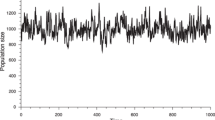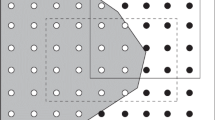Abstract
The reasons why tests for density dependence often differ in their results for a particular time-series were investigated using modelled time-series of 20 generations in lenght. The test of Pollard et al. (1987) is the most reliable; it had the greatest power with the three forms of density dependent data investigated (mean detection rates of 50.8–61.1%) and was least influenced by the form of the density dependence in time-series. Bulmer's first test (Bulmer 1975) had slightly lower power (mean detection rates of 27.4–56.8%) and was more affected by the form of density dependence present in the data. The mean power of the other tests was lower and detection rates were more variable. Rates were 24.6–46.2% for regression of k-value on abundance, 6.4–32.6% for regression of k-value on logarithmic abundance and 0.2–13.7% for Bulmer's second test (Bulmer 1975). Bulmer's second test is not useful because of low power. For one method, regression of k-value on abundance. density dependence was detected in 19.9% of timeseries generated using a random-walk model. For regression of k-value on logarithmically-transformed abundance the equivalent figure was 18.3% of series. These rates of spurious detection were significantly (P<0.001) greater than the generally accepted 5% level of type 1 errors and so these methods are not suitable for the analysis of time-series data for density dependence. Levels of spurious detection (from random-walk data) were around the 5% level and hence were acceptable for Bulmer's first test, Bulmer's second test, and the tests of Pollard et al. (1987), Reddinguis and den Boer (1989) and Crowley (1992). For all tests, except Bulmer's second test, the rate of detection and the amount of autocorrelation in time-series were negatively correlated. The degree of autocorrelation accounted for as much as 59.5–77.9% of the deviance in logit proportion detection for regression of k-value on abundance, Bulmer's first test, and the tests of Pollard et al. and Reddingius and den Boer. For regression of k-value on abundance this relationship accounted for less of the deviance (29.4%). Independent effects of density dependence were largely absent. It is concluded that these are tests of autocorrelation, not density dependence (or limitation). Autocorrelation was found to become positive (which is similar to values from random-walk data) as the intrinsic growth rate became either small or large. As the strength of density dependence (in the discrete exponential logistic equation) is dependent on the product of the intrinsic growth rate and the density dependent parameter α it is unclear whether this is because of variation in the strength of density dependent mortality or reproduction per se. However, small values of the intrinsic grwoth rate cause the amount of variation in the data to become small, which might hinder detection of density dependence, and large values of the intrinsic growth rate are coincident with determinstic chaos which hinders detection. The user of these tests for density dependence should be aware of their potential weakness when variation within time-series is small (which itself is difficult to judge) or if the intrinsic growth rate is large so that chaotic dynamics might result. Power and levels of variability in rates of detection using Reddingius and den Boer's test were intermediate between those of the test of Pollard et al. and Bulmer's first test. This, combined with the strong relationship between rates of detection of limitation and the value of the autocorrelation coefficient, make testing for limitation similar to testing for density dependence. Crowley's test of attraction gave the widest range of mean detection rates from density dependent data of all the tests (20.4–60.6%). The relative rates of detection for the three forms of density dependent data were opposite to those found for Bulmer's first test and the test of Pollard et al. I conclude that testing for attraction is a complementary concept to testing for density dependence. As dynamics represented in time-series generated using a stochastic form of the exponential logistic equation became chaotic, Bulmer's first test, the test of Pollard et al. and regression of k on abundance failed to detect density dependence reliably. Conversely, Crowley's test was capable of detecting attraction with a power between 96 and 100% with time-series containing both stochastically and deterministically chaotic dynamics. This difference from other tests is in agreement with the lower influence of autocorrelation.
Similar content being viewed by others
References
Bellows TS Jr (1981) The descriptive properties of some models for density dependence. J Anim Ecol 50: 139–156
Bulmer MG (1975) The statistical analysis of density dependence. Biometrika 31: 901–911
Cox DR (1970) Analysis of binary data. Monographs on statistics and applied probability. Chapman and Hall, London
Crowley PH (1992) Density dependence, boundedness and attraction: detecting stability in stochastic systems. Oecologia 90:246–254
Crowley PH, Johnson DM (1992) Variability and stability of a dragonfly assemblage. Oecologia 90:260–269
Dempster JP (1983) The natural control of butterflies and moths. Biol Rev 58:461–481
Diggle PJ (1990) Time series. A biostatistical introduction. Oxford statistical science series 5. Clarendon Press, Oxford
Gaston KJ, Lawton JH (1987) A test of statistical techniques for detecting density dependence in sequential sequences of animal populations. Oecologia 74:404–410
Hassell MP, Latto J, May RM (1989) Seeing the wood for the trees: detecting density dependence from existing life-table studies. J Anim Ecol 54:323–334
Holyoak M, Lawton JH (1992) Detection of density dependence from annual censuses of brakcen-feeding insects. Oecologia 91:425–430
Itô Y (1972) On the methods for determining density dependence by means of regression. Oecologia 10:237–372
Kuno E (1971) Sampling error as a misleading artefact in key-factor analysis. Res Popul Ecol 13:28–45
Latto J (1989) The analysis of density dependence in insect populations. Unpublished Ph.D. thesis, Imperial College, University of London
Maelzer DA (1970) The regression of log (N n+1) on log(N n) as a test of density-dependence: an exercise with computer constructed density-independent populations. Ecology 51:810–822
Manly BFJ (1991) Randomization and Monte Carlo methods in biology. Chapman and Hall, London
May RM (1974) Biological populations with non-overlapping generations: stable points, stable cycles and chaos. Science 186:645–647
May RM (1989) Detecting density dependence in imaginary worlds. Nature 338:16–17
Maynard Smith J, Slatkin M (1973) The stability of predator-prey systems. Ecology 54: 384–391
McCullagh P, Nelder JA (1989) Generalized Linear Models, 2nd ed. Chapman and Hall, London
Mountford MD, Rothery P (1992) Density-dependent populations. Nature 356: 391
Nelder JA, Wedderburn RWM (1972) Generalised linear models. J R Stat Soc A 135: 370–384
Neumann JW von (1941) Distribution of the ratio of the mean square successive difference to the variance. Ann Math Stat 12:367–395
Pollard E, Lakhani KH, Rothery P (1987) The detection of density dependence from a series of annual censuses. Ecology 68: 2046–2055
Reddingius J, den Boer PJ (1989) On the stabilization of animal numbers. Problems of testing. 1. Power estimates and estimation errors. Oecologia 78: 1–8
St Amant JLS (1970) The detection of regulation in animal numbers. Ecology 51: 823–828
Slade NA (1976) Statistical detection of density dependence in a series of sequential censuses. Bull Ecol Soc Am 57: 35
Slade NA (1977) Statistical detection of density dependence from a series of sequential censuses. Ecology 58: 1094–1102
Stiling PD (1987) The frequency of density dependence in insect host-parasitoid systems. Ecology 68:844–856
Stiling PD (1988) Density-dependent processes and key-factors in insect populations. J Anim Ecol 57:581–594
Turchin P (1990) Rarity of density dependence or population regulation with lags? Nature 344:660–663
Varley GC, Gradwell GR (1960) Key factors in population studies. J Anim Ecol 29:399–401
Vickery WL (1991) An evaluation of bias in k-factor analysis. Oecologia 85:413–418
Vickery WL, Nudds TD (1984) Detection of density dependent effects in annual duck censuses. Ecology 65:96–104
Vickery WL, Nudds TD (1991) Testing for density-dependent effects in sequential censuses. Oecologia 85:419–423
Woiwod IP, Hanski I (1992) Patterns of density dependence in moths and aphids. J Anim Ecol 61:619–630
Author information
Authors and Affiliations
Rights and permissions
About this article
Cite this article
Holyoak, M. New insights into testing for density dependence. Oecologia 93, 435–444 (1993). https://doi.org/10.1007/BF00317889
Received:
Accepted:
Issue Date:
DOI: https://doi.org/10.1007/BF00317889




